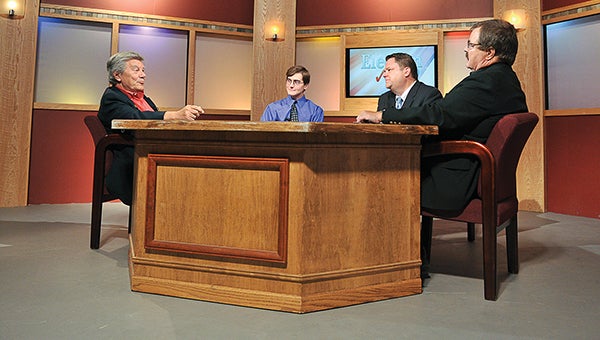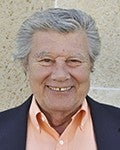Election Preview: Lang v. Stiehm
Published 7:38 pm Friday, November 2, 2012

Austin Mayor Tom Stiehm, right, and opponent Dick Lang take part in a round-table debate with moderators Eric Olson of KSMQ and Trey Mewes of the Austin Daily Herald at the KSMQ studios earlier this month. -- Herald file photo
In the end, money will decide the race for Austin’s mayor.
Incumbent Tom Stiehm defends his record as mayor of a booming city with a lot of progress toward improving local quality of life. Challenger Dick Lang seeks to curb government spending and lower tax increases to residents. Both candidates have similar views when it comes to public service and city government, but their approaches to service substantially differ.
The background
“As a businessman, I look at things different than Tom,” Lang said.
Lang, a lifelong Austin resident, grew up on the east side of town, never straying far from his roots.
“I’ve been on 10th Street NE all my life,” he said.
Throughout his career, Lang has picked up and run a variety of businesses, from his long-standing Lang Construction — now H&L Construction — to Bobee Jo’s the bar he built and opened in 1984, which he sold to his children last year. He also owns a hotel/boarding house, rents out several properties, and at one time owned several Mason City businesses.
Lang served on the Austin City Council from 1997 to 2002, eventually campaigning for a spot on the Mower County Board of Commissioners, which he served on from 2003 to 2010 before losing his seat to commissioner Tony Bennett. Lang served for a number of years as chair of the Mower County DFL Party and also worked on several legislative campaigns, including Paul Wellstone and Hubert Humphrey.
His time on the county board was largely dominated by the Mower County Jail and Justice Center, the new jail built downtown which caused controversy over where or even whether it should be built for several years.
Lang is proud the county finished building the jail.
“If we wouldn’t have built a new jail, we would have had to close it,” he said, adding the county would have to ship prisoners to other counties, which would have been more expensive in the long run.
Lang said the jail benefited the community in a variety of ways, including the clean-up of the nearby land between Second and Fourth Avenue NE. He points to his service getting the jail built and figuring out how to pay for it as strengths he would bring to the mayor’s office.
When the board originally voted to put the jail next to Austin Municipal Airport, Lang work with commissioners to get another vote on the location to keep it downtown, and helped the board figure out how to pay for the new justice center.
Stiehm is no stranger to the new jail issue, as he was one of several local officials advocating for the jail to come downtown.
“When I got in my first term, that was basically the issue,” he said.
A long-time Austin resident, Stiehm grew up in Milwaukee and served in the Marine Corps. before heading to Austin in 1976 to work in the Austin Police Department. He eventually became a detective and left the force in 2006, shortly after winning his first term in November of that year. Since then, he has presided over a flood renovation project, an increase in population and what could be a boom in the local economy.
Stiehm lauds the city’s success in encouraging growth and expansion among local businesses, and especially touts The Hormel Institute’s expansion as a victory for Austin residents. Austin Port Authority officials helped secure $13.5 million for a second expansion this past legislative session, and the project was also encouraged by Gov. Mark Dayton.
That expansion is one of more than a dozen building and expansion projects either planned or taking place in town over the past two years.
“If you look at what’s going on in Austin right now, our building permits are surpassed only by Rochester in this area,” Stiehm said. “We’re building, a lot of businesses are expanding.”
Stiehm also points to an increasingly diverse population and Vision 2020, the community improvement project, as proof the city’s guidance and support is moving Austin in the right direction. Stiehm said it wasn’t the city’s job to start these projects, but rather provide the right environment and offer key support when necessary — such as a $10,000 grant from the Austin City Council to help Vision 2020 start-up costs — that allowed the community to grow.
“[Vision] 2020 is for the betterment of the city,” Stiehm said. “We can’t neglect 2020. We have to be involved in it and [organizers] want us to be involved in it.”
The issues
Both candidates have similar ideas on running the city. Both talk about finding synergies and cost-saving measures to run the city better for less, and each acknowledges the call by voters to restrain spending and keep taxes low.
“It’s what people are asking for,” Stiehm said. “It’s not what the city council needs or wants, it’s what the people want. I think they’re demanding that cuts be made or government be trimmed.”
Lang has built his campaign around cutting government spending and refusing to raise taxes.
“You’ve got to cut government spending,” Lang said.
Stiehm touts the city council’s success in cutting the budget in recent years, despite decreasing Local Government Aid from the state and a large increase in property taxes from the loss of the Homestead Market Value Tax Credit. Though the city cut its budget by 4 percent last year, Stiehm said most residents remember the 13 percent increase in property taxes instead. This year, the city council proposes a 4.6 percent tax levy increase for 2013, though that number could go down by the time the city finalizes next year’s budget in December.
That isn’t enough, according to Lang, who said the city’s taxes have increased by 44 percent over the past eight years in a recent debate between the two. Lang said Austin needs to be more progressive in its thinking, and try to solve problems instead of get rid of them.
“Every problem’s an issue,” Lang said. “A lot of times, elected people don’t listen to the people. That’s why I’ve been so fortunate, that I’ve had a good record working with the people.”
Lang hopes to find more synergy between city and county government, such as the highway department sharing equipment. He also wants to see the city take an active role in downtown Austin, like encouraging businesses to buy the vacant lot between Third and Fourth Avenue N on Main Street N. or finally repairing the bathrooms inside the Town Center building. The city opted to close off the bathrooms instead of fixing them as a cost-saving measure.
“Instead of tearing the bathrooms out, we’ve got to get it fixed up,” Lang said. “If there’s a problem, correct the problem.”
Stiehm said the city is pursuing synergy with the county, like the new street cleaning machine which both city and county employees will be able to use. Yet Stiehm believes it’s unrealistic to promise to cut spending and refuse to raise taxes without cutting the services Austin residents have come to expect.
“What we try and do is give people what they want,” he said. “If you’re going to cut taxes, then we’ll talk about services.”
Stiehm said he’s often found new city council members or city employees who are looking to cut things from the budget without realizing the consequences behind those cuts. Even if the city did nothing, budget expenses would still rise by about 2 to 3 percent every year to keep up with inflation, according to Stiehm.
“If you say you’re going to freeze the budget, tell me what services you’re going to cut,” he said. “When we go to the people with these things, they don’t want services cut, they don’t want snowplows to wait until morning.”
The race
Make no mistake, each candidate has disagreements over their opponents’ record. Lang criticizes the city’s spending and Stiehm’s record of cooperation with the council. Stiehm has had several high-profile disagreements with Council Member Marian Clennon, which notably culminated in the 2010 mayoral race between the two.
“You don’t have to be an island unto yourself,” Lang said.
Stiehm criticizes Lang’s stance against spending as unrealistic and views Lang’s low-spending, no government increases campaign promises as a U-turn from his role increasing county taxes to pay for the new jail. Lang was one of the commissioners who supported the new building in the 3-2 vote on whether the jail should be built, and the jail arguably played a large part in the 2010 county commissioner election that Lang lost.
“He’s an old politician, but you have to look at what people do, instead of what they say,” Stiehm said. “You can look at what’s going on in the city right now, our city is thriving.”
The election
Stiehm and Lang beat out Marian Clennon, Joey Miller and Jerald Kelly in the Aug. 14 primary to face each other this November. Whoever wins will be the executive officer of the city for the next four years, a term change enacted by voters last year. While they may differ slightly in terms of tax issues, each candidate will have to remember the biggest rule if elected to office: they need to work together and listen to the people, something each claims to be successful at.



